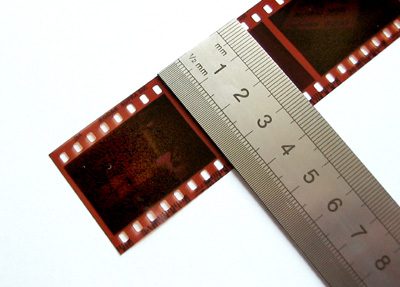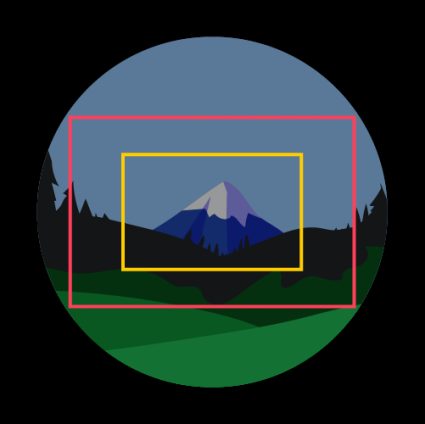Crop Factor Calculator
Omni's crop factor calculator will let you know what your camera and lens combination looks like in terms of a 35mm full-frame sensor size camera.
It calculates both the 35mm equivalent focal length and aperture f-stop value (or f-number). This allows you to see how your image magnification and depth of field compares to a standard 35mm camera.
The text below explains how to calculate the crop factor and asks, does a crop sensor increase magnification?
Our depth of field calculator can help you with depth of field calculations.
What does 35mm mean?
Let's start by defining what we mean by a 35mm full-frame camera. It all began in 1934 when Kodak introduced 135 film cartridges. The film inside was 35 mm (1.4 in) wide, and each image was 36 by 24 mm in size. This size was known as the full-frame format.

As photography went digital and manufacturers replaced film with digital optical sensors, it was convenient to produce sensor sizes the same as the old film (at least for high-end cameras). This compatibility allowed you to keep using your existing lens with a new digital camera, and the image would be the same.
What is a crop sensor camera?
Producing such a large image sensor is expensive. You can obviously save money by making a smaller sensor. However, if you still use your old 35mm lenses, the magnification and aperture f-stop of those lenses is altered (and so is the depth of field).
So, if your camera has a sensor smaller than a full-frame camera, it is called a crop sensor camera. We use the word "crop" because the smaller sensor's resulting image is a cropped image of the larger full-frame image, as in the illustration below. In other words, it changes the field of view of the camera. For further reading, head to our camera field of view calculator.

How to calculate crop factor?
The crop factor compares the image sensor sizes to the full-frame sensor size. To accommodate different aspect ratios of sensors, it is defined as the ratio of the diagonal length of the 35mm sensor to that of the crop sensor:
where:
- – crop factor;
- – diagonal length of 35mm film; and
- – diagonal length of the sensor.
Here is a list of common crop sensor sizes and their respective crop factors.
Name and camera type | Width (mm) | Height (mm) | Crop factor |
|---|---|---|---|
1/2.5" - superzoom and point-and-shoot cameras | 5.76 | 4.29 | 6.0 |
1/2.3" - compacts and compact superzooms | 6.17 | 4.55 | 5.6 |
1/1.8" - high-end compacts | 7.11 | 5.32 | 4.8 |
1/1.7" - high-end compacts | 7.53 | 5.70 | 4.5 |
2/3" - e.g. Fujifilm X10 & X20, Sony F828 & F717 | 8.80 | 6.60 | 3.9 |
1" - e.g. Nikon 1/CX, Sony RX100-series & RX10 | 13.2 | 8.80 | 2.7 |
4/3" - Four Thirds | 17.3 | 13.0 | 2.0 |
APS-C - Canon | 22.2 | 14.8 | 1.62 |
APS-C - General, e.g. Nikon DX, Sony α DT | 23.6 | 15.6 | 1.53 |
Half-frame - Olympus Pen F | 18 | 24 | 1.44 |
APS-H - Canon and Leica M8 | 27.9 | 18.6 | 1.29 |
35mm full frame - Canon EF, Nikon FX, Sony α, FE-Mount | 36.0 | 24.0 | 1.0 |
You can also get medium and large format cameras, which our crop factor calculator also supports. These cameras have sensors or film larger than the 35mm full-frame size, so the crop factor is less than 1.
We can see how lenses designed for full-frame digital sensors or 35mm film will produce images on different-sized sensors when we know the crop factor.
How to use the crop factor calculator?
The first thing to do is to select your camera's sensor size from the list of sensor sizes. An example image will appear when you do this, showing how much smaller or larger your sensor is compared to the standard full-frame sensor.
You can then input the focal length of your camera's lens and the aperture f-stop you are interested in using. The calculator will apply the crop factor and tell you the focal length and f-stop in terms of 35mm full-frame equivalents.
As with most Omni calculators, it also works backward. Let's look at a common problem when choosing lenses for crop sensor cameras.
You have an APS-C camera with a crop factor of 1.53x (a super 35 crop factor), and you want to buy a lens that will give the same image as a 50mm f/4 full-frame lens. Here's what you do:
- Select the Sony APS-C crop factor with a value of 1.53x from the list of sensor sizes. Now the calculator is an APS-C focal length calculator.
- Go to the second section, "35mm full-frame equivalents", and input a focal length of 50 mm and an f-stop of 4.
- The calculator will then do the calculation
50 / 1.53 = 32.68 = 33 mm, meaning you would need a lens with a focal length of 33 mm, so the image is equivalent to one formed with a 50 mm full-frame lens. - To calculate the f-stop needed it does
4 / 1.53 = 2.61 = f/2.6. So the aperture f-stop to get the same depth of field would need to be f/2.6.
💡 If you want to use a focal reducer to teleconverter lens attachment, input the adaptor's magnification. Values less than 1 are for a focal reduce and greater than 1 for a teleconverter.
Want to explore some more optics calculators? Why not check out these three handy calculators:
Does a crop sensor increase magnification?
The short answer is yes, it does. It will increase the effective magnification of a 35mm-based lens by a factor equal to the crop factor. For example, the effective focal length of a lens with a focal length of 50mm on a crop sensor (let's say it's an APS-C sensor) will be 50 × 1.53 = 76.5 mm.
However, this magnification effect is due to the image being cropped by the smaller sensor. While you will gain in magnification, you will lose in terms of image quality. For example, in low-light conditions, you will need to open up the lens aperture or decrease the shutter speed to get enough light onto the sensor. These adjustments will alter the depth of field and your ability to get a sharp image, respectively.
What happens to the depth of field? - F-stop settings
Using a crop sensor will deepen the depth of field (the part of the image that is in focus) by the crop factor. So if your 50 mm lens has a maximum aperture of f/2.0 on an APS-C sensor with a crop factor of 1.53, the f-stop value will be 2.0 × 1.53 = 3.1.
So, by using a crop sensor, you'll lose some of the bokeh effects of your lens. That is why on modern smartphone cameras with tiny sensors, manufacturers have implemented portrait modes to simulate a shallow depth of field using software.
FAQs
What is the crop factor in a digital camera?
The crop factor is a measure of the ratio between the length of the diagonal of a full-frame sensor and the diagonal of a smaller sensor. A high crop factor indicates a smaller sensor that may cause a noticeable fraction of the shot to be left out of the sensor itself in the case of lenses with a big aperture. Knowing the crop factor of your camera helps you choose the best-fitting lenses for your set-up.
How do I calculate the crop factor?
To calculate the crop factor of a sensor, follow these easy steps:
- Measure or find the length of the diagonal of your sensor.
- Divide the length of the diagonal of a full-frame sensor by the length you measured in the previous step.
The result is the crop factor of your sensor.
How do I calculate the full-frame equivalents?
To find the full-frame equivalents, proceed with these steps:
- Calculate or find the value of the crop factor of your sensor.
- Divide desired focal length by the crop factor to find the focal length you must use in your shots.
- Divide the full-frame aperture by the crop factor to find the setting you need to emulate a full-frame shot.
What is the crop factor of an APS-C sensor for Canon?
The crop factor of Canon's APS-C sensors is 1.62. The value is different from other APS-C sensors from other brands. In this case:
-
Find the dimensions of the sensor:
-
Width = 22.3 mm; -
Height = 14.9 mm.
-
-
Find the diagonal with Pythagora's theorem:
d = sqrt(222² + 14.8²) = 26.68 -
Divide the length of the diagonal of a full-frame sensor (
43.26 mm) by the previous result:CF = diagonal full-frame/diagonal crop sensor = 43.26/26.68 = 1.62
The result is the crop factor of an APS-C sensor by Canon.
